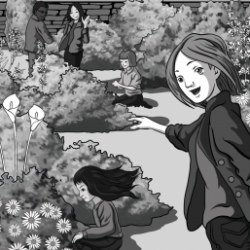Source Institutions
Source Institutions
Add to list Go to activity
Activity link broken? See if it's at the internet archive

In this activity, learners are invited to imagine the park of their dreams! In small groups, learners place moveable pieces on a grid, iterating on their plan together to create a plan for a community park. A variety of park features are offered as choices to include on the map, including a playground, skate park, water features, picnic areas, trails, and more. Like real-world projects, the plan is limited by the realities of space and funds. For younger learners, groups are limited to choosing less than 10 features. Learners ages 9 and up are limited not by the number of features, but by their cost in terms of points: They are challenged to keep track of the points on the park features cards and use less than 250 total points. Some park features, including a natural wetland and ice cream shop, promise to provide revenue back to the community and are worth points. Others, like a skate park or swimming pool, "cost" points. This activity is part of a curriculum designed to engage learners in hands-on engineering challenges.
- 10 to 30 minutes
- 45 to 60 minutes
- $1 - $5 per group of students
- Ages 4 - 11
- Activity, Lesson/Lesson Plan, Simulation
- English
Quick Guide
Materials List (per group of students)
- 1 (27" × 17" or so) blank sheet of graph paper (with 1-inch square rule)
- 1 (8½" × 11") set of Park Features, preferably printed on cardstock at actual size, and cut into individual pieces
- 1 (44") length of brown, tan, or gray yarn
- 1 pair of safety scissors
- 10 yellow pony beads in a small container (such as a cup or baggie)
- 1 (8½" × 11") Be Creative…Be an Engineer! poster (for tweens, teens, and adults), preferably printed in color
- 1 (8½" × 11") Grand Challenges of Engineering poster (for teens and adults) (optional)
- coloring supplies (optional)
Subjects
-
Engineering and Technology
-
Engineering
- Civil Engineering
- Environmental Engineering
-
Engineering
-
Life Sciences
-
Ecology
- Human Impact
-
Ecology
-
The Nature of Science
- Science and Society
- Science as a Career
-
The Nature of Technology
- The Design Process
Informal Categories
- Financial Literacy
- Model Building
- Nature and Environment
Audience
To use this activity, learners need to:
- see
- read
- touch
Learning styles supported:
- Involves teamwork and communication skills
- Uses STEM to solve real-world problems
- Involves hands-on or lab activities
Other
Components that are part of this resource:
Includes alignment to state and/or national standards:
This resource is part of:
Access Rights:
- Free access
By:
- Department of Education and Public Outreach, Lunar and Planetary Institute; STAR Library Education Network
Rights:
Funding Source:
- NSF, DRL-1010844
